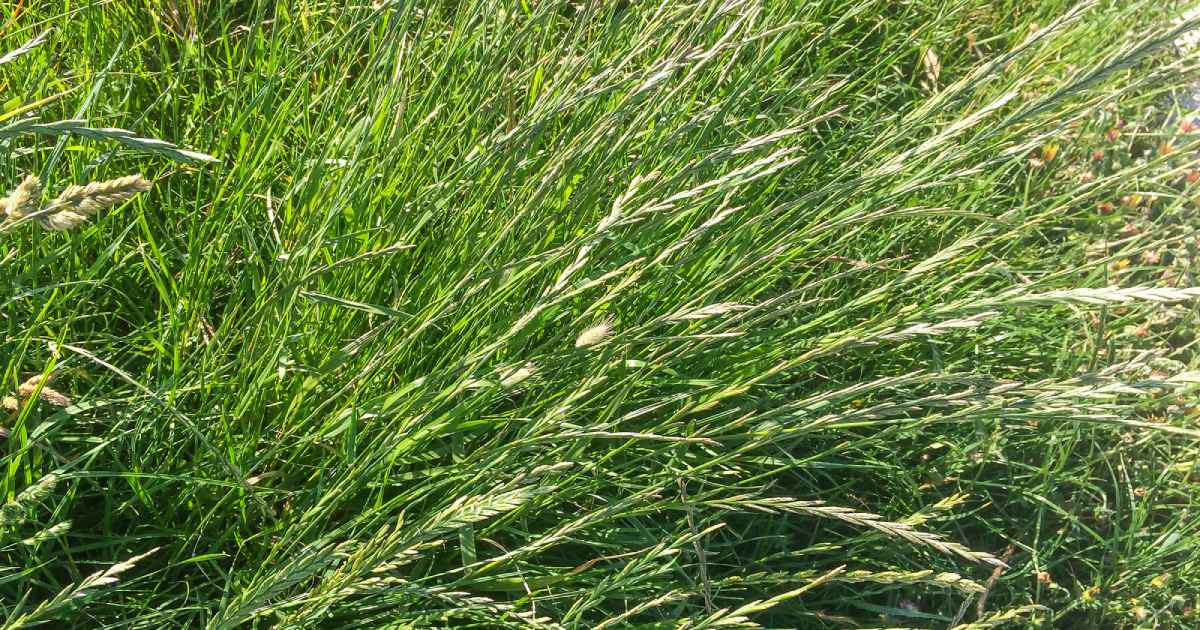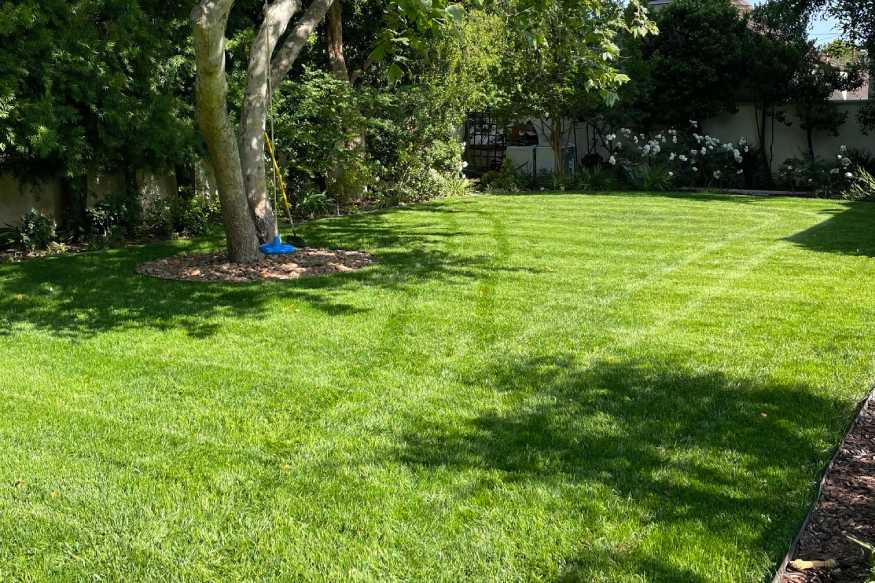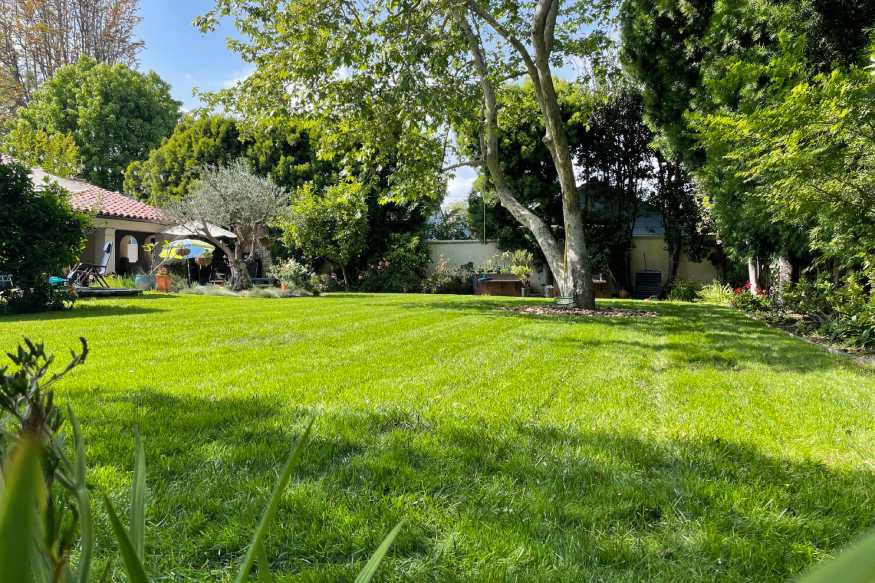Perennial ryegrass is celebrated for its rapid establishment, dark coloration, and soft, fine blades. Its strengths make it a popular grass throughout the United States. But its weaknesses are what determines when and how it is best utilized.
In this guide, we’ll look at important perennial ryegrass characteristics to determine if it’s right for your yard. We’ll also tell you everything you need to know to care for this moderately-high maintenance grass using our easy-to-follow perennial ryegrass care calendar.
Perennial Ryegrass Overview
| Also Known As | Lolium perenne L. |
| Type of Grass | Cool season perennial |
| Optimal Zones | Mild northern zones |
| Root Structure | Deep |
| Winter hardiness | Good to excellent |
| Shade tolerance | Moderate |
| Water Requirements | High |
| Drought Tolerance | Good |
| Self Repair Capacity | Excellent wear tolerance |
| Overall Maintenance Requirements | Moderate to high |
History
Perennial ryegrass has been used in the US and abroad as livestock forage since the 1700s. Like many cool-season grasses, including Kentucky bluegrass, it is native to Europe and northern Asia.
It wasn’t until the 1960s that perennial ryegrass was cultivated as turf grass. These first varieties had a lot of weaknesses, including poor cold, heat, and drought tolerances. One thing they were good at though, was rapid establishment from seed.
This combined with improvements in mow quality led to perennial ryegrass becoming popular as an overseeding option in the South. Here, this fast-growing grass was used on golf courses to overseed warm-season grasses to provide color in the winter.
In time, this ryegrass became popular in northern states for permanent lawn use. Its popularity grew even more in the 1980s when horticulturalists bred endophytic fungus into the grass to give it supreme pest resistance. This fungus also made newer varieties more drought and stress tolerant.
Today, perennial ryegrass is still commonly used in southern states for winter overseeding. In terms of permanent installations, it is best suited for northern climates or transition zones with mild summers.
Perennial Ryegrass Growth Characteristics
Perennial ryegrass has a lot of unique characteristics and uses that make it suitable in a variety of situations. But it still has moderate to high maintenance needs.
To help you decide if perennial ryegrass is right for your home, let’s take a closer look at the characteristics of this grass.
Type of Grass
Perennial ryegrass is a perennial cool-season grass. “Perennial” meaning it comes back every spring. And “cool season” means it does most of its growing when temperatures are below 75 degrees.
Like Kentucky bluegrass and tall fescue, ryegrass grows the most in the spring and the fall. In mild climates, it can grow throughout the summer and winter as well.
Optimal Zones
For year-round use, perennial ryegrass is best suited for northern climates. It can be grown in transition zones assuming a milder summer. In southern areas, it is used exclusively for winter overseeding of warm-season turf.
Ryegrass Root Structure
Perennial ryegrass has one of the longest root structures of any cool-season grass. Roots can reach a depth of nearly two feet. This gives it an advantage in terms of drought tolerance.
However, the roots grow in an annual pattern and die off almost completely in the spring. For this reason, it is important to support root growth and avoid drought stress during this part of the year. With proper care, perennial ryegrass roots will be deep enough to survive periods of drought by summer.
Germination
Perennial ryegrass possesses an incredibly fast germination rate, making it well-suited to many applications. In conditions conducive to germination – such as the right temperature, water and soil contact – this species of grass can sprout within five to ten days, a remarkably short period of time compared to other types of grass.
Such an accelerated germination rate means that gardeners and landscapers alike can expect quick success when using perennial ryegrass in their projects.
Winter Hardiness
Newer cultivators of perennial ryegrass have excellent winter hardiness. They can typically survive in areas of extreme cold by going dormant and greening back up in the spring. Most varieties will stay green through winter if temperatures average above freezing.
Shade Tolerance
Perennial ryegrass has poor shade tolerance. It will germinate and grow rapidly in both shade and sunny conditions but is quickly crowded out by weeds and other grasses in shaded areas. It prefers full sun but many varieties can be grown in partial shade.
Water Requirements & Drought Tolerance
Despite its deep roots, perennial ryegrass still requires a good amount of water to thrive. Typically, it will need about 1 inch of rainfall or irrigation per week. But waterings can be spaced farther apart than most grasses so long as enough water is delivered.
In the spring, when roots are regrowing, more frequent waterings are needed.
By summer, once roots have been established, perennial ryegrass has a good drought tolerance. In mixed-grass lawns, it is typically the last grass to go dormant in dry conditions. However, prolonged periods without water will result in dead patches once the grass begins to regrow.
Self Repair Capacity
Perennial ryegrass has a very high wear tolerance compared to other cool-season grasses. It is a great choice for high-traffic areas because it does not die back with repeated use.
However, perennial ryegrass has limited self-repair abilities. It is a bunching grass that does not form rhizomes or stolons. If an area is worn down to the dirt, reseeding will be necessary.
Perennial vs Annual Ryegrass
The distinction between perennial and annual ryegrass is an important one for gardeners and landscapers to bear in mind.
The former, as its name implies, is a species of grass that stays alive over multiple growing seasons, while the latter – also known as annual rye – will die off at the end of each season.
This lower cost seed is often found in economy packages and can be useful for those looking to stretch their budget while still receiving good quality grass coverage.
Despite its single-season lifecycle, however, annual rye can provide a satisfactory level of lawn or flower bed maintenance until perennial ryegrass is planted in its place. In this way, it can be thought of as a sort of stepping stone between reseeding projects.
Knowing when and where to use perennial or annual ryegrass will be key to achieving the desired results in any gardening or landscaping project – so it pays dividends to fully understand both types before embarking on your endeavor.
Ryegrass Seed Blends
Perennial ryegrass is a great component for grass seed blends, and for good reason. This nurse grass germinates quickly and provides crucial shade and protection to other species of grass, such as Kentucky bluegrass, which can take up to three weeks to become established.
Kentucky bluegrass is a great companion to ryegrass due to the fact KBG spreads via rhizomes and also has a great ability to repair any damage to itself. The bluegrass helps to hold the ryegrass together and results in a more durable turf.
Perennial Ryegrass Lawn Care Calendar
Perennial ryegrass requires year-round care to look its best.
For new lawns, spread seed at a rate of 4 to 5 pounds per 1,000 square feet in the early fall. Alternatively, you can set seed in the spring as soon as winter temperatures begin to warm. Sprouts will appear quickly and grow rapidly.
Once the seedlings have reached 2 inches in height, you can begin following our perennial ryegrass lawn maintenance plan, below.
Spring Care
Perennial ryegrass grows the most in the spring. As such, it requires the most maintenance this time of year.
Mowing
Perennial ryegrass tolerates impressively low cutting heights for a cool season grass. Any height between ⅝” and 3” is tolerated. However, optimal growth is achieved between 1” and 2”.
Note: During the spring, when roots are dying back and regrowing, it is best to keep perennial ryegrass closer to 2 inches in height. Less frequent and less extreme trimming supports faster root growth.
Fertilization
This grass requires a higher amount of nitrogen than other cool-season grasses. However, too much can result in excessive growth, which can be detrimental during the spring when roots are developing. We recommend using a fertilizer that contains equal amounts of nitrogen and phosphorus this time of year to support root and leaf growth.
Fertilize every 4 to 6 weeks through the spring.
Weed Control
Apply a pre-emergent weed control option early in the spring. Use spot control weed killers on young weeds as soon as they sprout or pull them manually.
Watering
Perennial ryegrass requires 1 inch of water per week. Irrigation is not typically necessary during the first months of spring in most climates. As natural rainfall decreases, begin watering every other day to supply 1 inch of water over the course of each week.
Watering in the early morning is generally the best time. This period reduces water loss while restricting how long foliage stays wet to avoid fungus problems.
Pest and Disease Control
With adequate fertilization, perennial ryegrass is fairly disease resistant. However, it can suffer from snow mold early in the season. If you notice signs of this, treat your lawn with an appropriate fungicide.
Insects are rarely a problem for this type of grass. But keep an eye out for signs of infestation and treat with an insecticide if needed.
Aeration
Aerating should be done now if it was not completed in the fall. Do it once spring growth is at its peak. This will allow your grass time to recover before the hot summer temperatures.
Summer Care
Because perennial ryegrass is a cool-season grass, it does not grow much in the summer. If temperatures get too hot, it may even go dormant and turn brown. Summer maintenance is largely centered around keeping your lawn watered.
Mowing
For hot climates, set your mower height to 3 inches in the summer. This will help prevent sunscald and reduce stress as grass transitions into dormancy. For cooler climates, continue cutting to 1 or 2 inches in height, depending on preference. Assuming adequate watering, you’ll likely have to mow every week.
Fertilization
Perennial ryegrass will typically not need much fertilization through summer due to slowed growth. Once temperatures begin to drop at the end of summer, apply a nitrogen-rich fertilizer to feed the leaves and green your lawn up quicker.
Watering
Switch to less frequent, higher volume waterings in the summer. Two or three times a week is optimum with a total water delivery of 1 inch per week.
If you live in a dry climate, it may be more cost-effective to let your ryegrass go dormant. In this case, provide 1 inch of water every 2 to 3 weeks through weekly watering sessions.
Pest Control
While insect problems are unlikely, keep an eye out and treat as needed. Using targeted pest control methods is far more effective than blanket treatments.
Overseeding
For northern climates, if your grass suffered in the summer heat, you may want to overseed your lawn during the last month of summer. This will help fill any dead spots that do not come back.
Perennial ryegrass is notorious for coming back patchy after extended periods of drought. But, if your grass received enough water over the summer, overseeding is not necessary.
Fall/Autumn Care
If you live in a northern climate, autumn is all about preparing your lawn for winter. If you live down south, then this is the time of year when you want to overseed your warm season grass with perennial ryegrass for a green winter lawn.
Mowing
Fall mowing can be done at any height between ⅝” and 3”. But keep in mind, optimal growth is achieved between 1” and 2”. As the weather cools and growth increases, you’ll have to mow more often, typically once or twice per week.
Continuing mowing until growth stops.
Fertilization
Fall is the best time to have your soil tested to find out what nutrients are lacking. Choose the right fertilizer to supply these nutrients and apply it in September and again in early November. You want the last fertilization to come after the grass has stopped growing but while it is still green.
In addition to nutrient-specific fertilizing, we recommend a winterizer fertilizer. These specialty blends have all the nutrients your perennial ryegrass needs to survive the winter and come back stronger in the spring.
Watering
Continue watering as needed to give your perennial ryegrass 1 inch of water per week through the first months of fall. As temperatures drop, gradually decrease watering to ½ an inch per week.
Keep an eye on precipitation accumulation after your irrigation system has been winterized. If it’s a dry fall, you may have to hand water.
Pest Control
As you did in summer, treat pests only on an as-needed basis. Blanket pest control options are not as effective as targeted measures. Luckily, perennial ryegrass is fairly resistant to insects.
Aeration
Fall is a great time to have your lawn aerated to avoid compact soil if you didn’t do it in the spring. Aerated soil is better able to accept nutrients and water, making for a greener start to the new year.
Because perennial ryegrass doesn’t spread via rhizomes you do not have to worry about dethatching it this or any other time of year.
Overseeding
Fall is the best time to overseed your lawn, if needed. For newer or thinning lawns, overseed with ryegrass to add density. This will help protect against spotty growth in the spring and help crowd out weeds.
If your lawn struggled this year, you may consider overseeding with tall fescue. This hearty cool season grass tolerates drought and heat better than perennial ryegrass. By mixing the seeds with your current lawn, you can take advantage of both grasses’ strengths.
If you live in the South, now is the time to overseed your warm season grass with perennial ryegrass.
Overseeding can be done as soon as fall arrives. Do so no later than 30 days before the first frost in order to give new sprouts time to establish.
Winter Care
In cold climates, winter perennial ryegrass maintenance will be minimal. However, if you live in a warmer climate, your grass will keep growing throughout the winter. In this case, follow our guidelines for spring maintenance for best results.
Watering
Watering is typically not needed in the winter. But, if you are experiencing a particularly dry winter, you may have to hand water on occasion. Shoot for about ½ inch of moisture each week.
Alternatively, you can let your lawn go fully dormant by reducing watering to 1 inch every 3 weeks.
Overseeding
In warm climates, perennial ryegrass can be seeded throughout the winter. In colder climates, you can spread seed in late winter to get an earlier start in spring.
However, given how quickly perennial ryegrass sprouts, this is rarely necessary. Instead, wait for temperatures to rise into the 60s then spread your seed and water well. You should see sprouts within a week.


